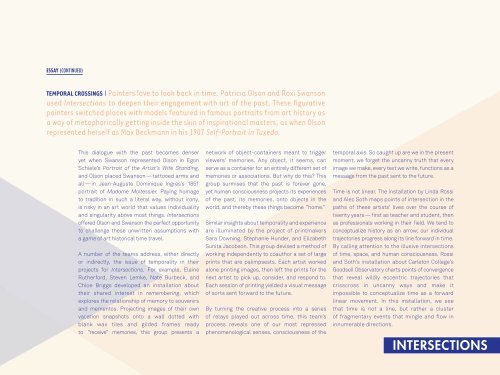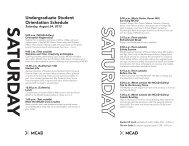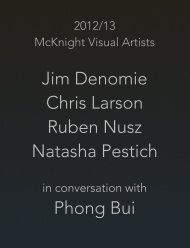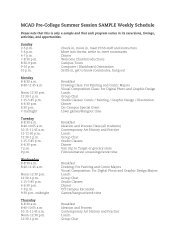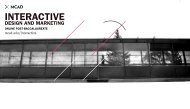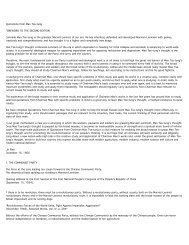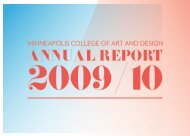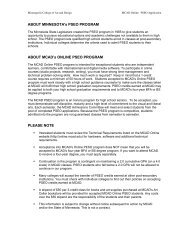Intersections Exhibition Catalog (PDF) - Minneapolis College of Art ...
Intersections Exhibition Catalog (PDF) - Minneapolis College of Art ...
Intersections Exhibition Catalog (PDF) - Minneapolis College of Art ...
Create successful ePaper yourself
Turn your PDF publications into a flip-book with our unique Google optimized e-Paper software.
ESSAY (CONTINUED)<br />
TEMPORAL CROSSINGS | Painters love to look back in time. Patricia Olson and Roxi Swanson<br />
used <strong>Intersections</strong> to deepen their engagement with art <strong>of</strong> the past. These figurative<br />
painters switched places with models featured in famous portraits from art history as<br />
a way <strong>of</strong> metaphorically getting inside the skin <strong>of</strong> inspirational masters, as when Olson<br />
represented herself as Max Beckmann in his 1907 Self-Portrait in Tuxedo.<br />
This dialogue with the past becomes denser<br />
yet when Swanson represented Olson in Egon<br />
Schiele’s Portrait <strong>of</strong> the <strong>Art</strong>ist’s Wife Standing,<br />
and Olson placed Swanson—tattooed arms and<br />
all—in Jean-Auguste Dominique Ingres’s 1851<br />
portrait <strong>of</strong> Madame Moitessier. Paying homage<br />
to tradition in such a literal way, without irony,<br />
is risky in an art world that values individuality<br />
and singularity above most things. <strong>Intersections</strong><br />
<strong>of</strong>fered Olson and Swanson the perfect opportunity<br />
to challenge these unwritten assumptions with<br />
a game <strong>of</strong> art historical time travel.<br />
A number <strong>of</strong> the teams address, either directly<br />
or indirectly, the issue <strong>of</strong> temporality in their<br />
projects for <strong>Intersections</strong>. For example, Elaine<br />
Rutherford, Steven Lemke, Nate Burbeck, and<br />
Chloe Briggs developed an installation about<br />
their shared interest in remembering, which<br />
explores the relationship <strong>of</strong> memory to souvenirs<br />
and mementos. Projecting images <strong>of</strong> their own<br />
vacation snapshots onto a wall dotted with<br />
blank wax tiles and gilded frames ready<br />
to “receive” memories, this group presents a<br />
network <strong>of</strong> object-containers meant to trigger<br />
viewers’ memories. Any object, it seems, can<br />
serve as a container for an entirely different set <strong>of</strong><br />
memories or associations. But why do this? This<br />
group surmises that the past is forever gone,<br />
yet human consciousness projects its experiences<br />
<strong>of</strong> the past, its memories, onto objects in the<br />
world, and thereby these things become “home.”<br />
Similar insights about temporality and experience<br />
are illuminated by the project <strong>of</strong> printmakers<br />
Sara Downing, Stephanie Hunder, and Elizabeth<br />
Sunita Jacobson. This group devised a method <strong>of</strong><br />
working independently to coauthor a set <strong>of</strong> large<br />
prints that are palimpsests. Each artist worked<br />
alone printing images, then left the prints for the<br />
next artist to pick up, consider, and respond to.<br />
Each session <strong>of</strong> printing yielded a visual message<br />
<strong>of</strong> sorts sent forward to the future.<br />
By turning the creative process into a series<br />
<strong>of</strong> relays played out across time, this team’s<br />
process reveals one <strong>of</strong> our most repressed<br />
phenomenological senses, consciousness <strong>of</strong> the<br />
temporal axis. So caught up are we in the present<br />
moment, we forget the uncanny truth that every<br />
image we make, every text we write, functions as a<br />
message from the past sent to the future.<br />
Time is not linear. The installation by Linda Rossi<br />
and Alec Soth maps points <strong>of</strong> intersection in the<br />
paths <strong>of</strong> these artists’ lives over the course <strong>of</strong><br />
twenty years—first as teacher and student, then<br />
as pr<strong>of</strong>essionals working in their field. We tend to<br />
conceptualize history as an arrow; our individual<br />
trajectories progress along its line forward in time.<br />
By calling attention to the illusive intersections<br />
<strong>of</strong> time, space, and human consciousness, Rossi<br />
and Soth’s installation about Carleton <strong>College</strong>’s<br />
Goodsell Observatory charts points <strong>of</strong> convergence<br />
that reveal wildly eccentric trajectories that<br />
crisscross in uncanny ways and make it<br />
impossible to conceptualize time as a forward<br />
linear movement. In this installation, we see<br />
that time is not a line, but rather a cluster<br />
<strong>of</strong> fragmentary events that mingle and flow in<br />
innumerable directions.<br />
INTERSECTIONS


